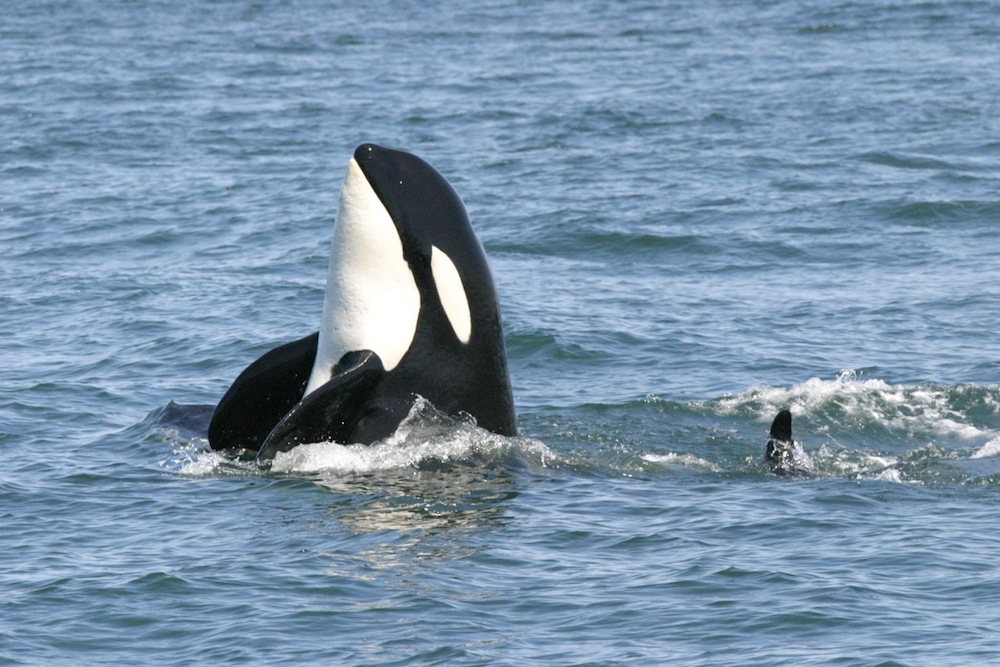Cacophony of Shipping Noise Found in Humpback, Killer Whale Habitat

Humpback whales and killer whales are losing up to 94 percent and 97 percent, respectively, of their communication space in the busiest areas of the ocean off the British Columbia coast, according to a new study.
Although this simplified summary represents a somewhat pessimistic interpretation of 10,000 hours of underwater noise levels in various sites off the coast that yielded highly variable results, researchers say the finding is helpful because it demonstrates a method that tries to interpret what those noise levels might mean to fish or whales.
"On average, what we found is, the habitats that are most important to resident killer whales — both northern and southern populations — are the noisiest of the sites we are studying," said Rob Williams, study leader and a whale researcher with the sea mammal research unit of the University of St. Andrews in Scotland.
The areas most preferred by humpback and fin whales are quieter, he added, but there may be no legal protection to keep the sites that way. The study focused on three whale species, but the researchers hope to expand their work to more marine creatures, such as fish. [Video: Humpback Whales Sing Their Tunes]
Shouting above the dial tone
Whale vocalizations serve many purposes, as far as researchers can tell. Calls can be used to coordinate whale movements to find food or head to mating grounds. Fish also emit calls: For example, male cusk-eels flex their muscles to emit mating calls through the water.
Marine creatures can communicate across tens of miles, but no one knows just how far whales are using and responding to the acoustic information that may be contained in their songs, or how well they are able to compete with the noise from human ocean activities. Fin whales, in particular, have very loud calls, making it easy for them to shout above ship noise at short distances, the researchers found, whereas calls made by humpbacks and killer whales are fainter and, therefore, more likely to be masked by ship noise.
Get the world’s most fascinating discoveries delivered straight to your inbox.
"We really don't have good information on the size of the habitat that the whales are using," Williams told LiveScience. "You can say the whale's acoustic space is being reduced by 50 percent or 80 percent, but that is relative to our best guess about the range the whales are using."

The calls were recorded on a device built by the Bioacoustics Research Program at Cornell University, led by co-author Christopher Clark.
The underwater microphones, called "pop-ups," were placed on the seabed and programmed to record ship noise, whale calls or anything else that went by, collecting 4 terabytes of data between 2008 and 2010. The team sailed back to each deployment site in the fall, and played an underwater sound to retrieve the recorder.
"It's like pressing a garage-door opener: The machine is smart enough to listen for that signal and nothing else," Williams said. "It releases an electric current that burns through a wire, and they slowly pop up to the surface with hard drive and electronics intact."
Involving the whale community
Williams' team decided to crowdsource their work as much as possible to cut down on research costs. Local boat taxis, whale watchers, scientists and other people on the water were asked to deploy and pick up all 12 microphones and associated equipment, which weighed anywhere between 200 and 500 lbs. (90 and 230 kilograms) depending on the equipment's configuration. Williams said his improvised collaborators were eager to help.
Noise is an easy thing to fix in oceans that are facing acidification, a warming climate and other situations that would take decades to address, Williams added. To cut down on the cacophony, ships could slow down or avoid whale-filled areas, or manufacturers could construct quieter vessels, he suggests.
The funding for the research came from a wide range of individual donors and private foundations, including the National Fish and Wildlife Foundation in the United States, the Marisla Foundation and the Canadian Whale Institute.
A study based on the research was recently published in the journal Animal Conservation. Some members of Williams' team also did a study showing increasing humpback-whale populations in British Columbia that was published in the journal PLOS ONE in September.
Follow Elizabeth Howell @howellspace. Follow us @livescience, Facebook & Google+. Original article on LiveScience.

Elizabeth Howell was staff reporter at Space.com between 2022 and 2024 and a regular contributor to Live Science and Space.com between 2012 and 2022. Elizabeth's reporting includes multiple exclusives with the White House, speaking several times with the International Space Station, witnessing five human spaceflight launches on two continents, flying parabolic, working inside a spacesuit, and participating in a simulated Mars mission. Her latest book, "Why Am I Taller?" (ECW Press, 2022) is co-written with astronaut Dave Williams.
